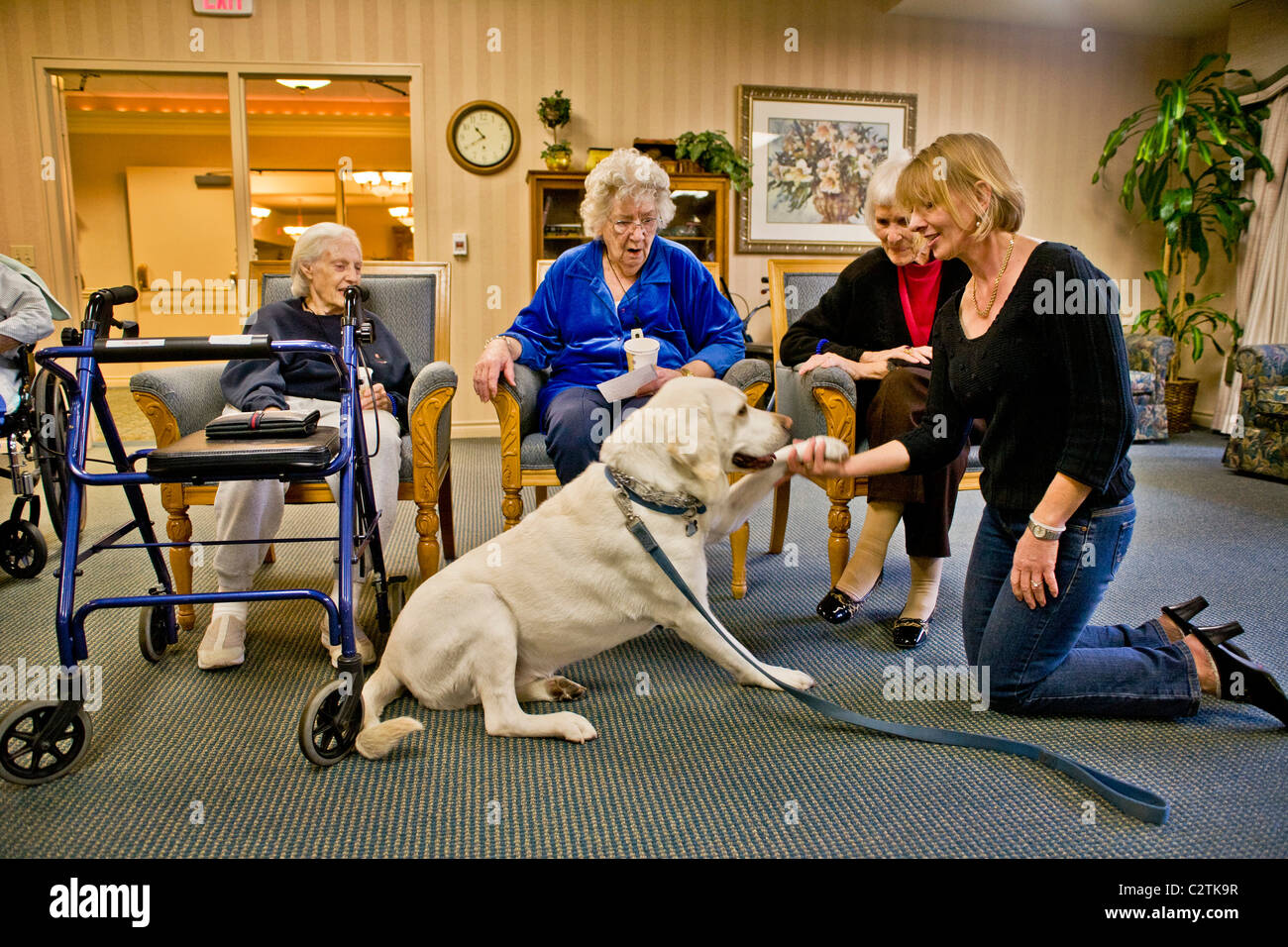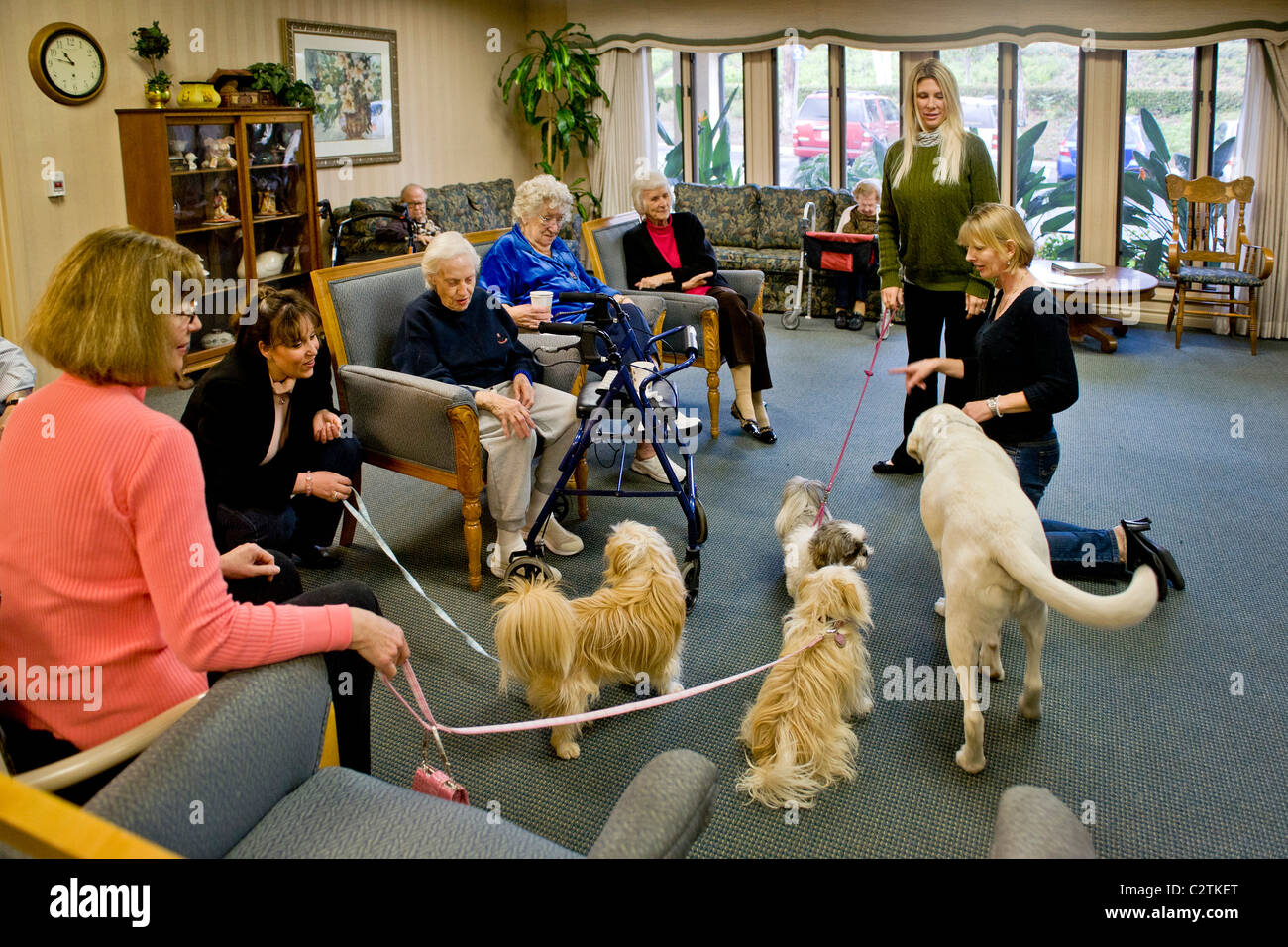Pet Partners Therapy Animal Program - Program widely available across the United States Canada Italy Japan Korea Mexico Norway and several other countries. Trains pet owners and pets on how to visit nursing homes hospice hospitals physical therapy centers long-term care facilities and other facilities to provide animal assisted activities.
 Nursing Home Residents In Mission Viejo Ca Play With Therapy Dogs Brought By Volunteers To Provide Companionship Stock Photo Alamy
Nursing Home Residents In Mission Viejo Ca Play With Therapy Dogs Brought By Volunteers To Provide Companionship Stock Photo Alamy
Residents who have been in the nursing home for quite a long time can experience depression due to their.

Pet therapy in nursing homes. The Benefits of Pet Therapy for Seniors. But many nursing homes now will allow personal pets to visit or may schedule pet visits with an animal-assisted therapy group Aggieland Pets With A Purpose or APWAP is a local non-profit animal-assisted therapy organization. Here we compared the ability of a living dog Dog and a robotic dog AIBO to treat loneliness in elderly patients living in LTCF.
What is Pet Therapy. The purpose to animal assisted therapy in nursing homes is to provide companionship pet therapy and a change in routine nursing homes activities. Lots of nursing homes across the country have introduced live-in pets.
Pet therapy is a low-stimulation form of therapy for elders especially those who live in nursing homes. ANIMAL ASSISTED THERAPY IN NURSING HOMES. The cat or dog will be provided with proper living accommodations.
Less than half of the nursing homes had policies regarding hand hygiene procedures for injuries such as animal bites or staff training around pets. If therapy animals are invited to a facility or other setting follow the steps below. Elders who experience.
Loneliness is a common problem in long-term care facilities LTCF and previous work has shown that animal-assisted therapy AAT can to some degree reverse loneliness. Dogs in nursing homes have shown to decrease elderly depression loneliness and stress and are a valuable resource for long-term care facilities. Pet Therapy is a broad term that includes animal-assisted therapy.
During their stay in the nursing home elders can become vulnerable to experiencing lower. This is arguably the most familiar kind of pet therapy for the elderly and involves animals usually dogs or cats visiting nursing homes hospitals and senior centers to spend time with patients and residents. Pet-assisted therapy in the nursing home setting as a vital component of the Eden Alternative or Human Habitat program is gaining widespread recognition and implementation.
Robopets in care homes. One reason is because of the emphasis on making facilities such as nursing homes and assisted living centers more homelike. Reduce feelings of hopelessness.
Pet therapy also called animal-assisted therapy for people with Alzheimers and other kinds of dementia has received increased attention over the last several years. In comparison with a control group not. As with other therapies there are concerns to be taken into account.
There are many benefits to pet therapy including increased self-esteem and increased mental and physical activity. ANIMALS IN NURSING HOMES B. Acquiring a cat or dog for institutional therapy programs places demands upon the insti-tution to ensure the welfare of the cat or dog and the protection of residents from injury related to the animal.
Programs such as this help to improve the quality of life of nursing home residents by offsetting resident loneliness helplessness and boredom. Future research should focus on refining the use of dog visits to make them more interactive and tailored to. It is now a growing field in Nursing Homes Hospitals and Special Schools to help people recover andor cope with health issues.
In a recent study that took place over a range of nursing homes research shows that pet therapy may actually delay the aging process. Instil a sense of purpose. APWAP members and their pets usually dogs or cats visit many assisted-living and nursing home facilities in the Bryan College Station community.
Therefore residents get to enjoy the animals loving attention without having to care for the animal. This is a longitudinal study with before and after intervention variables measurement in two groups of patients of a nursing home for elderly people. By encouraging physical exercise and socialization the research showed a big increase in mental function during and for some time after the pet therapy sessions.
Although no longterm effects were found there may still be beneficial shortterm effects that warrant the use of dog visits as a nonpharmacological intervention in nursing homes. Therapy animal visits require some level of contact between clients and the therapy animal. What Is Pet Therapy.
The aim of this study is to verify the effectiveness of pet therapy in improving well-being in the elderly living in a nursing home. Follow local guidance and facility protocols for physical distancing masks and other ways to prevent COVID-19 from spreading. Using pet- or animal-like robots robopets avoids some of the challenges of using live animals for pet therapy in care facilities such as concerns about hygiene allergies and animal welfare.










